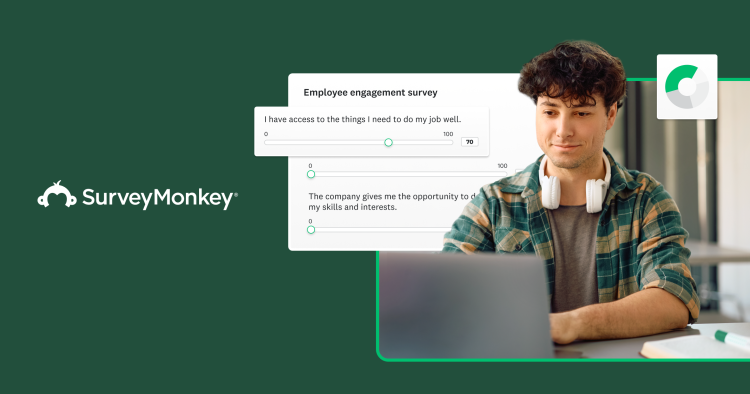Decisions that make a difference: Using feedback to shape the future of business

In this guide:
Business decision-making today
The pandemic tested businesses’ ability to problem solve, requiring organizations to make rapid and critical decisions often overnight. Business leaders grappled with urgent questions like: how can we set up our employees for success in a remote or hybrid-remote work environment? What technology do we need to continue operating safely and securely? Should we close down our restaurant or opt for a take-out model?
Previously, decisions like these were often made without key stakeholder input. But in this rapidly changing world, you can no longer rely on your gut instincts alone. Making sound business decisions depends on getting the right stakeholder input to guide your strategy.
To help leaders navigate to successful business outcomes, we set out to understand how businesses can make informed decisions to overcome complex challenges, grab hold of new opportunities, and make the necessary changes to move their business forward. Based on our years of experience helping businesses collect and act on feedback, as well as research insights from 250 C-level executives and hundreds more professionals across HR, CX, IT, and marketing, this guide identifies key decisions businesses need to make in the coming years, roadblocks standing in the way, and expert tips for leveraging feedback to define your strategy.
The 3 As of business decision-making in the new normal
Business decision-making post-pandemic has some new complexities to it. These include the rapidly evolving needs of customers, employees, and the market; the increasing burden of data silos preventing teams across the organization from accessing the information they need; and the accelerated speed at which decisions need to be made.
Anticipate needs
In competitive markets, you’ll need to keep pace with the needs of your customers, employees, and market—but to stand out from the pack, it’s even better if you can anticipate them.
Access to information
To be successful, decision makers need access to the right information to inform their strategies so they can make business decisions quickly and confidently.
Agile response
When external circumstances evolve quickly, you’ve got to stay tuned in, curious, and agile in order to engage and respond in real-time and put a plan into action fast.
Anticipate needs: Why active listening is the critical first step
Employee preferences look very different than they did just a few years ago. Consumer behavior is rapidly changing. And market uncertainty and economic volatility have changed how we do business. When change is the only constant, the only way to keep up is to get to know your stakeholders and how their perspectives and habits are impacted by the crises and societal transformations happening around us.
To stay one step ahead—of your customers, employees, market, and competitors—you should consistently be listening to understand current needs and detect any changing habits or preferences before they become widely known.
In a recent study of 250 C-level executives, 88% say feedback data is very or extremely valuable at their company when making business decisions. What’s more, executives at companies that value feedback the most were nearly 20x more likely to feel extremely confident in their ability to pivot based on new information, compared to those that found feedback somewhat or not so valuable.
By actively listening to feedback from your customers, employees, and market, your business can gather the insights it needs to move forward intelligently—and feel confident in that move, too.
Access to information: How feedback data can fuel innovation across the org
Maybe you’ve asked the right questions, and you’ve got a good amount of insights about what your buyers or employees expect. But before it can have an impact, you’ll need to get these insights into the hands of employees across the organization—from front line staff who need it to provide customer service, to decision makers who need feedback data to fuel their strategy—preferably from a single source of truth and integrated with other data collected by the business, such as transactional and operational data.
Siloed data remains a big challenge for many organizations. In fact, 52% of C-level executives report they’re concerned about how to break silos to keep employees connected.
Making sure your company has access to feedback data from a centralized location is important for getting everyone on the same page and aligned on the next steps required.
Agile response: Taking proactive action on insights
Companies that successfully get ahead of their stakeholders’ needs, and have a process for getting insights into the hands of the decision makers that need them, are better set up to take action proactively.
In situations where you need to act quickly—for instance, to jump on a new opportunity before your competitors get there first—proactive companies have an advantage. By taking action in anticipation of future problems or needs, proactive companies are always one step ahead.
Proactivity can also ease some of businesses’ biggest worries. In our study, C-level executives that reported their company is mostly reactive in responding to buyer needs were 62% more likely to worry about meeting diversity, equity, and inclusion (DEI) promises, 56% more likely to worry about rising customer expectations, 25% more likely to worry about breaking data silos, and 21% more likely to worry about collaboration and productivity, compared to their more proactive counterparts.
Applying the 3 A’s at your organization
For each of the departmental groups below, we’ll walk through one of the biggest decisions on your plate this year, who you’ll need input from, and the roadblocks standing in the way of your success. Then we’ll share some tips for using feedback to put the 3 As of business decision-making to work.

The workforce architects: How HR leaders can build a more diverse future of work
HR leaders strive to build an extraordinary workforce—one that’s engaged, motivated, and equipped to do its best work.
But attracting and recruiting the right talent takes a little more effort these days. Employees want to work for values-driven companies that have a strong company culture—one that really values employees. Companies want to build a diverse, equitable, and inclusive workforce; we’ve long known that diverse companies have access to a wealth of different perspectives that fuel better business decisions. By prioritizing equity and inclusion, companies empower creativity and innovation, and build cultures that are healthy, enduring, and productive.
This year, DE&I is top of mind for HR leaders. However, nearly half of C-level executives are worried about delivering on diversity, equity, and inclusion promises (48%).
The decision
How do we attract more diverse talent and keep existing employees engaged and productive?
The stakeholders
Employees, Senior leadership
The roadblocks
Employees don’t feel like they belong
A full quarter (26%) of employees don’t feel like they belong at their current company. Belonging is one of the hardest parts of inclusion to influence. You can’t usually change how welcoming employees are to one another, and the same words or actions might be considered hostile, neutral, friendly, or too friendly, depending on who you ask. Cultural sensitivities vary, and some of your employees might have backgrounds or ideologies that are directly at odds with one another.
Employee burnout
After over a year of escalating anxieties—due to multiple crises, prolonged stress, and the struggle to adapt to new work environments—there’s been a surge in employee burnout and concerns around productivity. In fact, 2 in 3 C-level executives admit they’re worried about employee mental health and burnout. This puts employee engagement and performance at risk.
Lack of diversity
Part of fostering employee wellbeing includes building a workplace that’s welcoming and inclusive to all. This requires taking a hard look at any workplace policies that may, inadvertently, introduce bias or cause inequitable employee experiences. A lack of diversity hurts businesses, too. Diverse perspectives help businesses to make better decisions and create products and services that are more accessible to all.
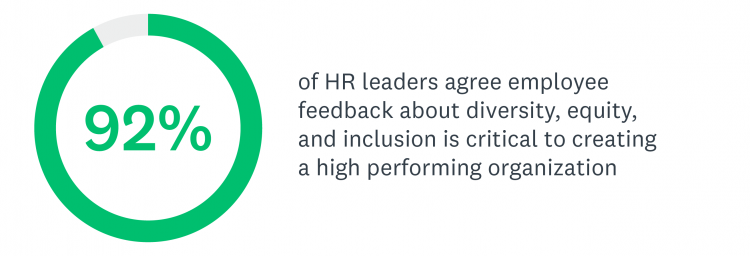
3 tips for making better HR decisions with feedback
1. Measure diversity and inclusion
As an HR professional, employees look to you to open a dialog and engage them in creating the kind of workplace where everyone is treated fairly and respectfully, has equal access to opportunities and resources, and can contribute fully to the organization's success.To start a dialog, send out regular pulse surveys to track changes to your employees’ sense of belonging and inclusion, as well as to measure trends and outcomes to drive ongoing improvement. Don’t be shy about asking for demographics—even in HR surveys that aren’t directly related to diversity and inclusion. Asking about race, gender, and sexual orientation in your surveys can feel personal and invasive, but respondents are rarely put off by them. Learn more about measuring diversity and inclusion and get access to free templates in our guide.
2. Connect DEI to employee engagement, retention, and performance
It’s hard to make an impact on diversity, equity, and inclusion without buy-in at the leadership level. Your survey data can help you get leadership’s attention. If your employees’ answers are troubling, it will create a sense of urgency around addressing them. If they reflect enthusiasm, you have a clear opportunity to boost engagement. Later in your feedback program, try combining your inclusion data with employee engagement and retention numbers to see if you can find a correlation.
3. Take employees along on the journey
A study by Tiny Pulse found that transparency is the factor most strongly correlated with employee happiness. Employees need to feel like they’re in the loop on major company changes. Once you’ve gathered feedback from employees, make sure to put insights into action—and stay transparent with employees about what you’re changing and why.
Ready to start measuring diversity and inclusion?
Check out our comprehensive DEI guide and get access to templates developed by expert survey researchers and industry experts.

The demand drivers: How marketers can adapt their approach to attract, engage, and retain buyers
Marketers aspire to create messaging and campaigns that resonate and add value to help their businesses stand out in crowded markets and attract the right people.
As we emerge from the pandemic and enter the new normal, marketers will have to grapple with how to: gather market insights to help reorient their business model in the new normal (60%); leverage customer insights to optimize campaign spending (58%); transition back to in-person events, conferences, and trade shows (55%); and update the marketing tech stack (41%).
The decision
How can we reorient our marketing model to better meet the needs of our customers and market in the new normal?
The stakeholders
Customers, The market, Senior leadership
The roadblocks
Rising acquisition costs
New customer acquisition is getting more expensive. While acquisition costs have been steadily rising for years, the pandemic accelerated the increase. This year, 46% of marketers reported it’s a top challenge. High acquisition costs have resulted in a reduced return on marketing spend and increasing prioritization of recurring revenue streams and customer retention.
Changing buyer behaviors & market uncertainty
Without the right data, understanding buyer behavior can be challenging in the best of times. But with market uncertainty and shifting customer loyalties brought on by the pandemic, tracking customer sentiment and behavior is more challenging today—and more vital.
Virtual fatigue
In 2020, marketers pivoted to drive traditional marketing activities such as trade shows, events, and other brand and pipeline building activities in a virtual format. But after over a year of online events, audiences are growing tired of the screen time. In-person events are looking to make a comeback, but many businesses have yet to reinstate business travel, and not everyone is comfortable just yet with joining thousands of their peers at a conference.
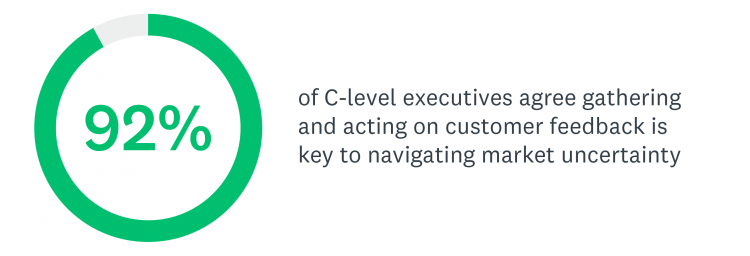
3 tips for making better marketing decisions with feedback
1. Listen to buyers
When competition is fierce, listening to buyers can help businesses stand out. To stay tuned in, survey your customer base or your target market at a consistent cadence to predict buyers’ changing needs, track awareness and sentiment, and ensure messaging resonates.
2. Find a balance between virtual and in-person events
Thinking about sponsoring or hosting an in-person event? Before you take the leap, get a feel for attendees’ comfort level. Sending a pre-event survey can help you gauge interest, identify concerns, and collect RSVPs. For virtual and hybrid events, gather feedback from attendees for a holistic view of the event—for instance, ask your attendees to rate specific sections and topics during a meeting or event, use surveys as a way for attendees to submit questions or help prioritize topics, or probe into what details they need to inform the agenda for your next meeting or event. Learn about the upcoming SurveyMonkey Zoom app here.
3. Connect feedback data to your CRM
By integrating feedback data directly into the systems you’re already working in—like Salesforce, Eloqua, Marketo, or another system of record—you can build richer customer profiles and personas to enrich leads and targeting.
SurveyMonkey marketing solutions
View our solutions that help marketers get the insights they need to drive growth, boost ROI, and retain customers.

The customer champions: How CX leaders can keep pace with rising expectations
CX leaders strive to amplify customers’ needs throughout the organization in order to better serve them—and create world-class experiences that keep them coming back.
Customers’ needs have fluctuated wildly over the past year. As organizations continue to adapt to changing customer priorities and invest more resources in retention efforts, the role of the CX leader will play a critical role in both informing top-down strategy with customer insights and putting action plans in place to improve the customer experience and drive loyalty.
The decision
What areas of the customer journey do we need to improve in order to deliver an exceptional customer experience?
The stakeholders
Customers, Cross-functional partners, Senior leadership
The roadblocks
Expectations are evolving fast
It’s hard to keep pace with rapidly changing customer expectations, and for many businesses it can feel like they can’t seem to make change fast enough. Our study of 250 C-level executives found more than half are worried about keeping up with rising customer expectations (55%). For instance, in recent years customers’ expectations have increasingly moved beyond good products and experiences to include good values—they expect the companies they do business with to be empathetic, values-driven, and willing to listen and quickly act on their feedback.
Hard to get buy-in from senior leadership
For CX initiatives to succeed, senior leadership needs to be in support of them. But in spite of customer satisfaction and retention being a top priority reported by 54% of C-level executives this year, securing resources, proving the value of their efforts, and getting buy-in from executives is a top challenge reported by nearly half of CX leaders (47%).
Hard to get cross-functional partners to take action on feedback
To move customer experience initiatives forward, CX leaders depend on their colleagues across functions like marketing and product to put customer feedback into action as they build their strategies and roadmaps in order to move the needle for customers. But getting other departments with different objectives and KPIs to do what’s best for the customer isn’t always an easy feat.
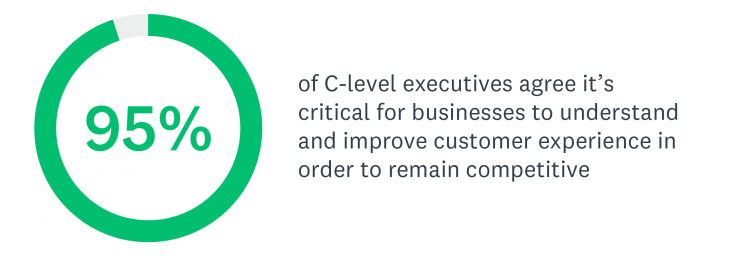
4 tips for making better CX decisions with feedback
1. Measure trends in customer preferences
Taking a proactive approach to CX can help you not just understand but also anticipate customers’ changing needs and preferences, so you can adapt and differentiate with exceptional CX. By monitoring key customer experience metrics like CSAT, NPS, and CES, you can detect any shifts in satisfaction or expectations and take action to improve the experience.
2. Share insights broadly
One of the biggest challenges in delivering a great customer experience is getting everyone in your organization on the same page as far as what needs to be prioritized first, and how. This starts with ensuring everyone has access to a central source of truth for customer feedback data, and processes for sharing out regular updates with the teams that need this information for their work and strategy-setting.
3. Combine data sets for richer insights
Joining your customer feedback data with other data sets like customer behavior data, company attributes, and financial data can help you get deeper insights, measure ROI, and drive action. By flowing CX data directly into your CRM, your organization can get a more holistic picture of customer health across the journey.
4. Focus on getting small wins
Moving quickly becomes challenging when there seems to be so many areas of the customer journey in need of an overhaul. That’s why it’s helpful to focus on getting small wins first. Not only does this help CX professionals prove the value of CX and get buy-in from leadership, but these small victories also show your customers that you’re listening and taking action.

CUSTOMER SPOTLIGHT
Golden State Warriors build a state-of-the-art fan experience using feedback every step of the way
When the Golden State Warriors moved from the Oakland Arena, their home base for 47 seasons, to the brand new, state-of-the-art Chase Center in San Francisco, they saw an opportunity. As the owner and operator of the new building, the Warriors now had an unprecedented chance to create a compelling fan experience—and they planned to exceed expectations.
Having successfully used SurveyMonkey for over 5 years, the Warriors selected SurveyMonkey Enterprise to keep a pulse on their fan experience and gather regular feedback for a number of important initiatives.
Schneider and team quickly got to work using the solution to gather input from fans, from their email content preferences to what they wanted the in-game experience to look like. Staying in lock-step with their customers’ preferences wasn’t just about getting new ideas for the arena—it was also the best way to be certain their business strategy and investments would drive results.
Read the full story

The data heroes: How IT leaders can improve security & productivity in the new normal
IT leaders aim to support business growth with the right tools while managing risk, protecting sensitive data, and integrating and democratizing the data being collected across the org.
In the coming months, 54% of the 201 IT pros we surveyed will need to set IT-related policies for working from home. As they plan for the new normal, 39% of IT professionals are worried about ensuring employees are safe as workplaces reopen, and 31% are worried about helping employees stay connected in remote and hybrid work environments.
The decision
What IT-related policies do we need to set for remote, hybrid, and in-office work environments to help employees stay productive and data stay secure?
The stakeholders
Employees, Cross-functional partners, Senior leadership
The roadblocks
Data silos and isolation
In remote and hybrid work environments, new struggles around connection, collaboration, and data sharing have emerged—exacerbating existing challenges with data silos. Over half of C-level executives are worried about data silos keeping employees disconnected, and 79% of IT professionals agree businesses that leave their data siloed in specific business functions, such as HR, marketing or customer experience, are putting themselves at a financial disadvantage.
Protecting sensitive data and managing risk
A couple of trends have put security and risk management in the spotlight: recent security breaches, and the COVID-19 pandemic, which has introduced new data protection concerns as employees work remotely and organizations move to cloud-delivered services. The pandemic has also introduced new forms of personally identifiable information (PII), such as symptom tracking, requiring new policies to be set to keep data safe and compliant. Managing business risk and sensitive employee data is top of mind for IT leaders, with 40% noting it’s a top priority for 2021.
Moving fast vs. staying in control
Often business decisions need to be made fast, but IT leaders are charged with protecting the organization from making mistakes that could jeopardize security or compliance. Often, IT leaders are in a position where they need to ask critical questions about where data is located, how it’s being handled, and if it’s under control—which can slow down the process.
The ability to respond to feedback quickly and with real progress has always been important, but the rapid change that occurred during the pandemic made it imperative. In our research, 52% of healthcare industry professionals said their organization has changed protocols due to the pandemic. With that kind of rapid transformation, asking follow-up questions takes on increased importance, since implementation doesn’t always guarantee success.
Take bedside manner, for example. At 53%, this is listed by our respondents as the most common reason for losing patient trust. Given that 57% of executives we surveyed plan on expanding their organization’s telehealth offerings, it will become increasingly essential to also assess “webside manner”—the art and science of connecting with patients when they’re on screen. Consider, for instance, subtle distinctions such as the seemingly simple but not-yet-second-nature need to look into the webcam to simulate eye contact. Training healthcare providers on the fundamentals of webside manner can make a huge difference when it comes to telehealth patient experience.
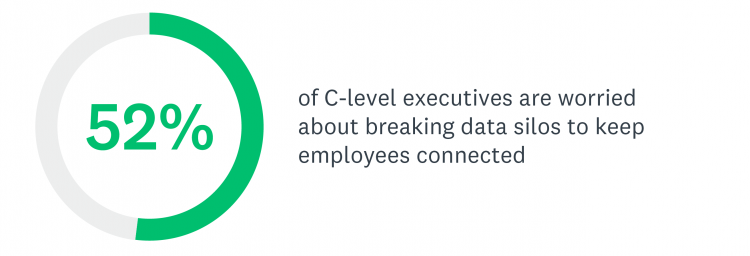
3 tips for making better IT decisions with feedback
1. Empower the organization with the right tools to drive productivity
Business decisions depend on having access to the right information, and IT leaders play an important role in bringing on the tools and solutions the organization needs to gather, understand, and act on this info. By connecting teams with an organization-wide feedback solution that offers admin visibility and control, IT leaders can break silos, keep data safe, and empower their organization to move forward intelligently.
2. Breaking silos and integrating data
Our study found 91% of IT leaders agree businesses that will thrive in the new normal will be the ones that build their data strategy around integrated, open tools, rather than closed systems of record.When data is left in silos, it isn’t used to its full potential. But feedback data is a very valuable source of data for decision makers across the organization. Industry leading survey platforms are offering integrations and APIs that make it easy to incorporate feedback into workflows, and allow users to work within the apps they use everyday.
3. Get the most out of digital transformation efforts
In the new normal, remote and hybrid work, virtual events, and increasing use of digital channels for marketing and ecommerce have placed digital transformation efforts front and center. To ensure your digital transformation initiatives are on track, gather feedback from internal teams that are charged with moving these projects forward. By gathering feedback from employees, you can understand their experiences with technology and where you should invest to improve productivity and satisfaction. Get fast ROI from your digital investments by taking action on feedback to improve end-user adoption.

CUSTOMER SPOTLIGHT
Chime is the largest and fastest-growing challenger in the mobile banking space. Chime powers its focus on members by bringing a centralized data flow to the entire organization.
Early on, Chime used the self-serve SurveyMonkey platform for collecting feedback on certain behavior sets and for researching industry competitors. As the company grew, Chime purchased additional accounts so more people could collect and share data. At one point, Chime was managing 15 separate accounts, which were a mix of paid individual and team accounts. With data protection and compliance being critical in the financial services industry, Chime decided to upgrade to SurveyMonkey Enterprise for its compliance and security features, and advanced capabilities.
This included single-sign on, PII management, the ability to track all user activity, sentiment analysis, and more.
7 ways IT can drive a winning data strategy
Download our eGuide to find out how IT leaders can handle a wealth of data in a way that is accessible, scalable, and actionable.

